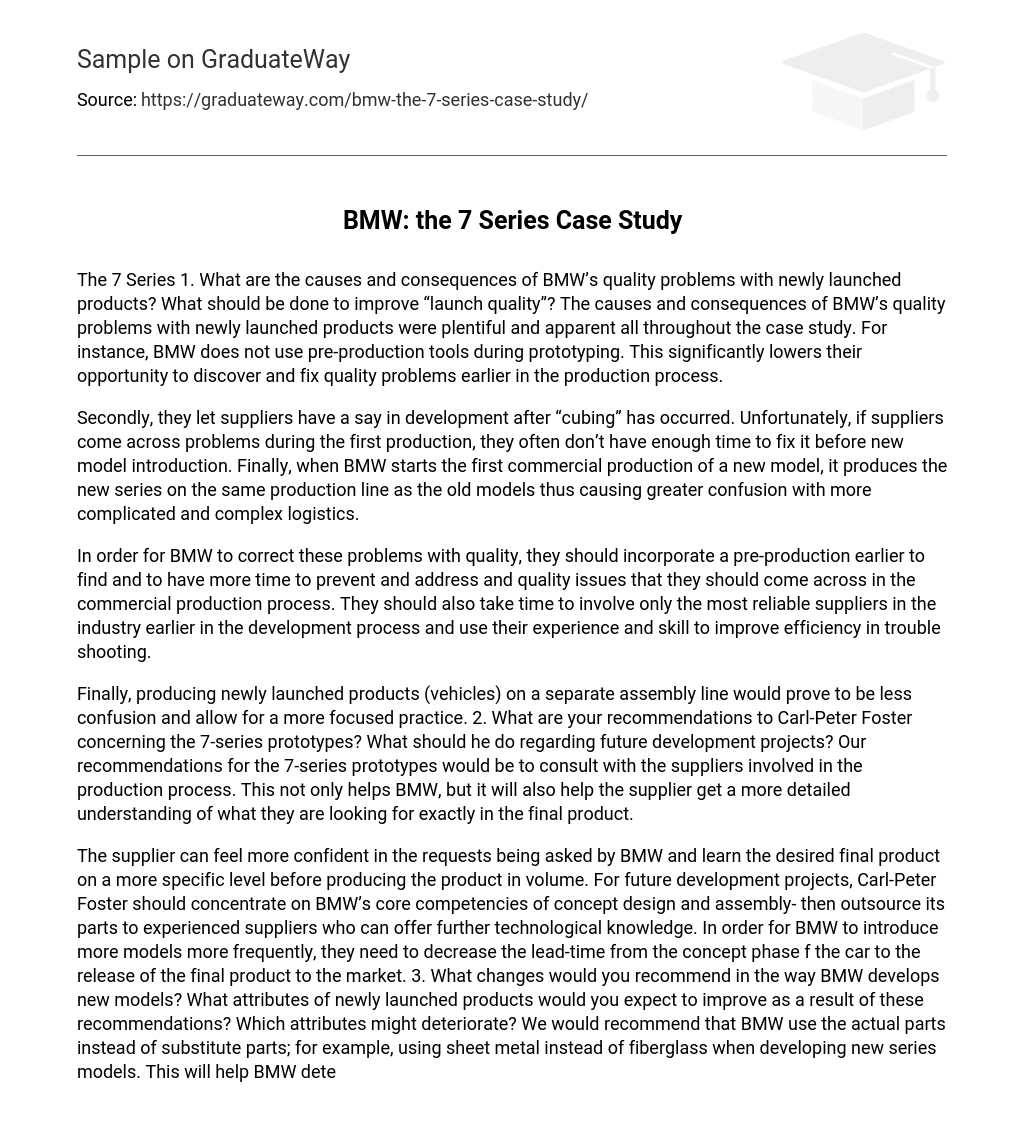The 7 Series 1. What are the causes and consequences of BMW’s quality problems with newly launched products? What should be done to improve “launch quality”? The causes and consequences of BMW’s quality problems with newly launched products were plentiful and apparent all throughout the case study. For instance, BMW does not use pre-production tools during prototyping. This significantly lowers their opportunity to discover and fix quality problems earlier in the production process.
Secondly, they let suppliers have a say in development after “cubing” has occurred. Unfortunately, if suppliers come across problems during the first production, they often don’t have enough time to fix it before new model introduction. Finally, when BMW starts the first commercial production of a new model, it produces the new series on the same production line as the old models thus causing greater confusion with more complicated and complex logistics.
In order for BMW to correct these problems with quality, they should incorporate a pre-production earlier to find and to have more time to prevent and address and quality issues that they should come across in the commercial production process. They should also take time to involve only the most reliable suppliers in the industry earlier in the development process and use their experience and skill to improve efficiency in trouble shooting.
Finally, producing newly launched products (vehicles) on a separate assembly line would prove to be less confusion and allow for a more focused practice. 2. What are your recommendations to Carl-Peter Foster concerning the 7-series prototypes? What should he do regarding future development projects? Our recommendations for the 7-series prototypes would be to consult with the suppliers involved in the production process. This not only helps BMW, but it will also help the supplier get a more detailed understanding of what they are looking for exactly in the final product.
The supplier can feel more confident in the requests being asked by BMW and learn the desired final product on a more specific level before producing the product in volume. For future development projects, Carl-Peter Foster should concentrate on BMW’s core competencies of concept design and assembly- then outsource its parts to experienced suppliers who can offer further technological knowledge. In order for BMW to introduce more models more frequently, they need to decrease the lead-time from the concept phase f the car to the release of the final product to the market. 3. What changes would you recommend in the way BMW develops new models? What attributes of newly launched products would you expect to improve as a result of these recommendations? Which attributes might deteriorate? We would recommend that BMW use the actual parts instead of substitute parts; for example, using sheet metal instead of fiberglass when developing new series models. This will help BMW detect problems earlier in the production process and make quality improvement a much easier task to achieve.
Since they are using suppliers that will manufacture parts using specialized tooling, BMW should also reduce the amount of prototype batches from five to three. The first prototype batch should be done using its current process of hand design, the second prototype will use pre-production process and the third will incorporate the use of specialized tools. Using this process will significantly decrease prototyping cost and lead time. As a result of these recommendations, the construction of prototypes for BMW will better resemble what the final product should look and perform like.
BMW will also be able to maintain its high quality image and increase its market share. BMW’s relationship with its suppliers will improve because they will be working closely with them in the designing process. An attribute that may pose threat for deterioration is employee skill; this would be due to increased automation. Flexibility with last minute changes requested by BMW customers may also become an issue. Over time, dependency on suppliers will also increase and prove to be a huge part of BMW’s success. 4.
What recommendations would you make to chairman Von Kuenheim regarding BWM’s strategy to compete against new Japanese entrants into the luxury car markets? In the past BMW has always been par or above when it came to its major competitors, but the entry of Japanese competitors into the luxury segment has completely changed the playing field. In order to remain competitive against Japanese competitors, BMW needs to remain focused on technology and innovation. Technology has proved to play a dominant role worldwide provides the greatest competitive edge for those who can implement and execute it correctly.
Also, it may seem like a mediocre and simplistic approach to running a business, but hiring the most committed, brightest, and hardworking employees will prove to be one of the most beneficial tools for the implementation of new technology. BMW must be committed to making these structural changes to assure application of quality assurance for their customers. Cost cutting efforts, pre-production tools, outsourcing and lead times will all lead to a more efficient production cost process, thus giving them the edge they need over Japanese entrants.





